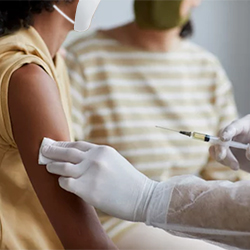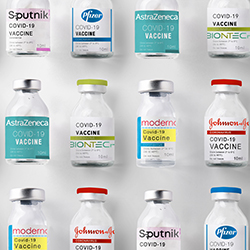By Marie Rosenthal, MS
The FDA authorized the emergency use of the Pfizer-BioNTech COVID-19 vaccine for children 5 through 11 years of age.

The authorization comes after a recommendation from the agency’s Vaccines and Related Biological Products Advisory Committee, which voted earlier this week to expand the emergency use authorization (EUA) of the vaccine.
The Pfizer-BioNTech COVID-19 vaccine for children 5 through 11 years of age is administered as a two-dose primary series, three weeks apart, but is only 10 mcg, which is lower than the 30-mcg dose used in those 12 years of age and older.
The FDA considered effectiveness data from an ongoing randomized, placebo-controlled study that has enrolled approximately 4,700 children 5 through 11 years of age. The study is being conducted in the United States, Finland, Poland and Spain.
“The FDA conducted a preliminary analysis of cases of COVID-19 among participants 5 through 11 years old occurring seven days after the second dose,” explained Peter Marks, MD, PhD, the director of the FDA’s Center for Biologics Evaluation and Research.
“In this analysis among participants without evidence of prior infection with SARS-CoV-2, three cases of COVID-19 occurred among 1,305 vaccine recipients and 16 cases of COVID-19 occurred among 663 placebo recipients. The vaccine was 90.7% effective in preventing COVID-19,” he said.
“The FDA also analyzed data that compared the immune response of 264 participants, 5 through 11 years of age, who received the lower dose to 253 participants 16 through 25 years of age from a previous study who had received the higher dose [30-mcg] vaccine. The immune responses of the younger children were comparable to the older participants,” Dr. Marks added at a press conference this evening.
The available safety data to support the EUA include more than 4,600 participants (3,100 vaccine, 1,538 placebo) ages 5 through 11 years enrolled in the ongoing study. In this trial, a total of 1,444 vaccine recipients were followed for safety for at least two months after the second dose.
Commonly reported side effects in the clinical trial included injection site pain, redness and swelling, fatigue, headache, muscle and/or joint pain, chills, fever, swollen lymph nodes, nausea, and decreased appetite. More children reported side effects after the second dose than after the first dose.
“More children reported side effects after the second dose than after the first dose, and the side effects were generally mild to moderate in severity, and occurred within two days after vaccination, and most went away within one to two days,” Dr. Marks said.
Pfizer Inc. has updated its safety monitoring plan to include evaluation of myocarditis, pericarditis and other events of interest in children 5 through 11 years of age. In addition, the FDA and CDC have several systems in place to continually monitor COVID-19 vaccine safety and allow for the rapid detection and investigation of potential safety problems.
“Our actions today, plus the CDC recommendations next week, will help us get closer to hopefully closing another chapter in this pandemic,” said Janet Woodcock, MD, the acting director of the FDA.
Although many cases of COVID-19 in children were mild or asymptomatic, “it’s important to note the data from the CDC that showed among children 5 to less than 12 years of age, there have been about 1.9 million reported cases of COVID-19,” she said.
In the United States, COVID-19 cases in children 5 through 11 years of age make up 39% of cases in individuals younger than 18 years of age. According to the CDC, approximately 8,300 COVID-19 cases in children 5 through 11 years of age resulted in hospitalization. As of Oct. 17, 691 deaths from COVID-19 have been reported in children younger than 18 years of age—146 of them among those 5 to 11 years old.
“Tragically, COVID-19 was among the top 10 leading causes of death for children 5 to 11 years of age,” she said, calling the statistics “startling.”
In addition, the FDA also authorized a manufacturing change for the vaccine to include a formulation that uses a different buffer, called tris(hydroxymethyl)aminomethane or Tris, which helps to maintain a vaccine’s pH and stability. This new formulation is more stable at refrigerated temperatures for longer periods, permitting greater flexibility for vaccination providers, Dr. Marks explained. “It’s commonly used as a buffer in a variety of other FDA-approved vaccines and biologics, including products for use in children. The FDA evaluated manufacturing data supporting the change in this inactive ingredient and concluded it did not affect the safety or effectiveness of the product.”
Although cases are going down as the Delta variant starts to wane, both physicians urged parents to get their children vaccinated.
“I feel obligated to say this: When I started internship to when I ended internship, I learned an incredible amount, but the most important thing I learned was that I didn’t know a whole lot,” Dr. Marks admitted. “And I’ll tell you in this pandemic, when we started to now, I’ve learned a lot, but what I’ve learned is I can’t absolutely predict where this is going.
“Although cases have calmed down, we still have a tremendous caseload of COVID-19 and we’re all going inside, and this delta variant spreads very well inside.
“I personally would think that it’s probably a good idea to try to get vaccinated because we just don’t know where this is going to go. ... We could have a winter surge, and it would just be, to me, the rationale here is protect your children so that they can get back towards normal lives, and so that you feel more comfortable with the activities that they would likely go about doing.
“Because I think that the tremendous cost of this pandemic has not just been in physical illness. It’s been in the psychological, the social development of children. So, that’s yet another reason to think about doing this,” Dr. Marks said.
“If I had young children in this age group, I would get them vaccinated,” Dr. Woodcock added.
The CDC’s Advisory Committee on Immunization Practices will meet next week to discuss clinical recommendations for implementation of the vaccine in children, and the vaccine should be available for children shortly thereafter, according to Dr. Woodcock.
“Vaccinating younger children against COVID-19 will bring us closer to returning to a sense of normalcy,” Dr. Woodcock said.




